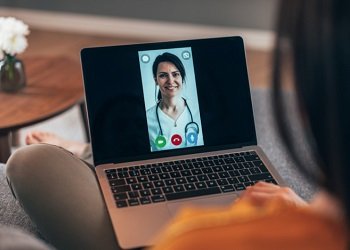
During a typical application cycle, clinical experiences are a crucial element of the medical school application. Significant health care experience through shadowing or volunteer work indicates to admissions faculty that you have thoroughly explored a career in medicine and confirmed it is right for you. After the pandemic upended our usual way of doing things, however, the process of learning about careers in medicine and gaining clinical experiences also had to adapt.
To learn more about virtual shadowing, the AAMC spoke with a medical student and a physician and professor from the George Washington University School of Medicine and Health Sciences, both of whom recently participated in virtual shadowing.
Q&A with Olivia Silva, second-year medical student
- Please describe your virtual shadowing experience, including how you found out about the opportunity.
My school had a shadowing program where they match students with providers to shadow over the summer. During COVID-19, the program went entirely virtual, which was a new experience for many students and providers.
I shadowed virtually during telehealth visits. The physician I shadowed is a cardiologist who is affiliated with my medical school's hospital. I shadowed on five different days, and I viewed approximately five patient encounters each day. I had minimal interaction with the patients. At most, I said hello and waved.
- What did you think of your experience? Was there anything that surprised you or anything unexpected that you learned?
Overall, I loved this experience and was surprised how much I gained from it. With shadowing experiences, I've realized that more is more. The more patient interviews, physicians, and specialties you see, the more informed you become. Every physician has a different perspective, and I find it helpful to hear as many as possible to guide my future practice. Also, shadowing virtually made it much easier and more accessible than traditional in-person experiences. You can shadow physicians outside of your geographic location, and it is easier to schedule into your schedule (no commute time).
- What advice would you give to other students to help them make the most of virtual shadowing?
Keep a Word document open so that you can jot down questions to ask the physician after! I find it's easier to write down questions while shadowing in the virtual environment because you can do it subtly without distracting the patient or provider.
Q&A with Punim Thakkar, MD, assistant professor of otolaryngology/head and neck surgery at the George Washington University School of Medicine and Health Sciences
- What makes virtual shadowing a worthwhile experience for students?
Telehealth is here to stay and is part of our "new normal" in medicine and surgery. In my opinion, it cannot replace an ENT visit, as our physical examinations are limited; however, I do think it has been of great value for my practice and for my patients. It is worthwhile for students because they still have the ability to shadow attendings as we take a thorough history, and when appropriate, students themselves can interview patients while their attendings observe them. Students can get feedback after the visit. Additionally, I see many follow-up patients via telemedicine, so I may discuss pathology results, imaging results, or potential surgical procedures for the future. I think virtual shadowing to observe such clinical decision-making is critical. I have also found imaging review is very helpful — where I can share my screen and make the CT, MRI, or ultrasound review educational for anatomy review for the students. Many patients appreciate this thorough scroll through of their imaging as well.
- How do telehealth visits differ from in-person visits?
Every patient has a different level of familiarity with telehealth platforms; therefore, it is not uncommon for the first five minutes of a visit to be resolution of technological issues. This differs from in-person visits. Additionally, complete ENT examinations are quite limited via telehealth.
- What advice do you have for students looking for virtual shadowing opportunities?
Virtual shadowing is a great way to get exposure to specialties that you think you may be interested in early in your medical training. If you have a half day available, it is very easy to shadow from the comfort of your home. You just have to find physicians who offer telehealth and reach out to them.
- What’s the best way for a student to approach a physician to inquire about virtual shadowing?
Email them and give them your availabilities — but be flexible!
- Is there anything related you’d like to share that you think would be helpful?
There has been a lot of literature across specialties regarding telemedicine. You should make yourself familiar with some of this; there are resources to optimize the experience for both patients and physicians. If you have access, get to know patients via their electronic medical records (EMR); this will be helpful to read about their diagnoses, consider differentials for their chief complaints, get familiar with their labs, imaging, pathology results, etc.
Send us your stories about your virtual shadowing experiences to aspiringdocs@aamc.org!